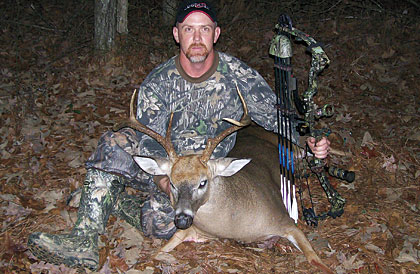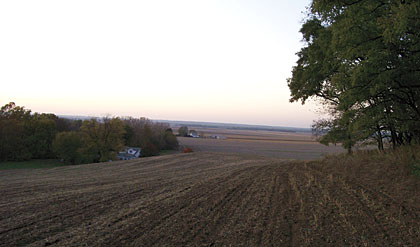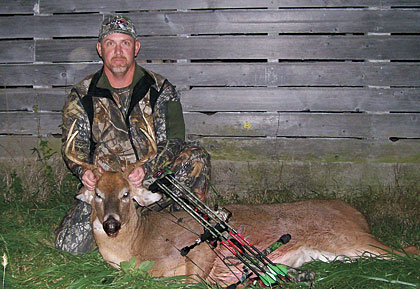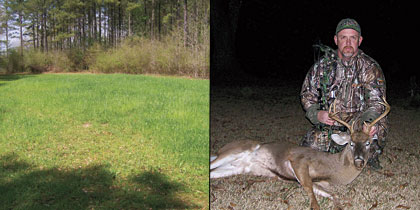March 10, 2011
By Jason Johnson
The best way to fool a deer's brain is to appeal to its stomach.
By Jason Johnson
"If you build it, they will come."
Advertisement

This Alabama six-point buck proved to me the value of building an oasis in the midst of a desert.
Advertisement
|
That was the famous line from the Kevin Costner movie Field of Dreams. The same can be said for food plots, deer fields, green patches, or whatever you call them in your part of the country. No matter where you live, food plots can bring deer within bow range -- if you tailor them for bowhunting.
Establishing food plots conducive to successful bowhunting involves more than just disking the ground and throwing out a bag of seed. Below are three food plot strategies I've used with success that will explain what I mean.
THE OASIS
Several years ago, I was hunting at the famous Tara Wildlife operation just north of Vicksburg, Mississippi. On the first afternoon of a three-day hunt, my guide dropped me off at a stand located on a fencerow along a Mississippi River levee. The stand overlooked a huge, unplanted crop field. Using my rangefinder, I found that the width of the field was 231 yards and the length was so great that my 800-yard rangefinder could not reach the field's boundary.
"They must think I have a .270 Winchester," I mumbled.
After relaxing for a moment, I realized that underneath my stand was a 40x40-yard food plot, trampled with deer tracks. The forage that had been planted in it had been browsed so heavily it looked like it had been run over with a lawnmower!

In Cass County, Illinois, rich soybean and cornfields provide deer with abundant food but little variety. |
About 30 minutes before sunset, deer started pouring over the top of the levee into the big crop field. As they crossed the large field, most all of the deer were drawn to the tiny food plot under my stand as to a magnet. In essence, the plot served as an oasis in the midst of a "desert" field for deer moving from bedding areas to oak flats along the river. I did not draw my bow on a deer that afternoon, but I did take home a new strategy for planting food plots.
Fast forward to the following September, when I began planning my food plots for the upcoming season. Part of my property has a large, fallow straw field that many deer cross between bedding and feeding areas. Opting for the oasis plan for a food plot in this large field, I prepared the ground, planted seed, applied fertilizer, and waited for what I hoped would be a whitetail magnet.
Several weeks passed before the wind direction was right to hunt my new plot. Soon after I'd settled into my Summit climber, the action began as two does appeared in the straw field about 100 yards away and walked steadily toward me. As they closed the distance to about 50 yards, a nice buck stepped out in the same spot where the does had first appeared and started a slow, steady pace to the oasis.
What seemed like an eternity passed before the buck and does finally reached the edge of the food plot. As if on automatic pilot, I drew my bow, settled my pin, and let the arrow fly. After a short tracking job, I had my oasis trophy.
VARIETY IN THE DIET
Food plots may have originated in the South, but they will work just about anywhere in the United States, as I observed while hunting whitetails in Cass County, Illinois, last year. If you have ever hunted this area, you know that it certainly could be the postcard picture for perfect whitetail habitat -- beautiful hardwood ridges intermingled with expansive fields of corn and soybeans.

I think this 10-pointer was seeking variety in his diet when he made the fatal mistake of visiting a small green plot one evening. |
The giant agricultural fields can intimidate any bowhunter, especially when the corn hasn't been cut and the deer can bed and feed without ever leaving the standing corn. While experiencing this scenario firsthand during my hunt last season, I concluded that greenfields might solve the problem of too much standing corn and beans.
Just like deer, I love corn and beans, but I don't want them for every meal, and neither do deer. Diversity in a diet is something that both humans and whitetails desire. The property I was hunting in Illinois has several food plots planted exclusively for deer with Buck Forage Oats, Mossy Oak BioLogic, and various other green offerings that would give deer an alternative to the day-in, day-out buffet of corn and beans.
After hunting over trails on the edges of crop fields for two days, I knew my strategy had to change for me to get a chance at a buck. A little scouting revealed that deer were hitting the green plots heavily. Maybe my theory about deer wanting variety in their diet had some merit. With this in mind, I grabbed my climber and headed for a food plot at the back edge of a huge cut beanfield.
The small green patch was tucked into a secluded dogleg of the field. My eyes were drawn to an old logging road, covered in deer tracks, that entered the southern end of the field. After finding a good tree, I climbed 20 feet and settled in.
About an hour before dark, a few does began to trickle into the plot. A few minutes later, a small six-point waltzed past my stand, and behind him came a decent 10-pointer. The buck was surely no record-book candidate, but he looked like a trophy to me, and I did not hesitate to send an arrow his way.
The recovery time was quick as the deer traveled only 20 yards after the shot. Reflecting on the hunt, I couldn't help but think about how well my strategy had paid off. Food plots work throughout the country for various reasons; in Midwest farm country, their biggest draw may just be the "green salad" diversity they provide deer in their diets.
NEW GROUND
My last food-plot trick came from a story my grandmother told to me. She grew up in poverty, and her father couldn't afford fertilizer for their annual crop. To remedy this situation, her father cleared new ground that had never been planted before. His theory was that because previous crops had not drained nutrients from the soil, the soil would be naturally fertile and productive.
My gr
eat grandfather's strategy paid off in a huge crop, saving his farm from foreclosure. Planting new ground for whitetails has several benefits, and it could save your hunting season much as it saved my great grandfather's farm.
The obvious benefit is that the soil will be fertile, thus yielding a more palatable crop for maximum drawing power. Deer definitely seek out the best-tasting, most nutritious food sources. If your plots fulfill these two whitetail requirements, you're in business.

(Left) Paying close attention to my grandmother's words, I planted a greenfield on new ground in Mississippi and was rewarded with this fine Southern eight-pointer. (Right) |
A second benefit is that deer are inquisitive and love to explore new food sources. Again, let me draw an analogy between me and deer. When a new restaurant opens, I am quick to try it out. Deer relate to a new food source and location in the same way. When you till a new area and release fresh earth scent into the air, deer will investigate the groundbreaking overnight.
A third new-ground benefit is that it gives you a definite element of surprise. Many hunters plant the same areas every year and hunt from the same trees or ground blinds each season. Over time, deer pattern their movements and stand sites. Planting in new areas and hunting from new stands keep deer guessing, a fact that has led to my success on many occasions.
For example, last July I cleared the brush from an area on my property and allowed the plot to sit idle until late August. I then tilled the ground until all the native grasses had been cut. I also hung a stand at that time. The next weekend I burned the plot to get rid of the dead grass from the prior week's tilling. My final move was a second tilling, preparation of the seed bed, planting, and fertilizing. The new-ground plot faired well and was now ready for hunting.
During early season, most of the deer were hitting mast crops. By December, however, they had depleted most of the mast and had begun to lock in on other food sources. One of those was my new-ground plot.
Finally getting the needed northeast wind, I climbed into my stand for the first time. About an hour before sunset, three does came in at the far end of the plot and began to feed. Ten minutes later I saw movement in the cover behind the feeding does, and my heart began to race as I saw it was a mature buck. As he walked into the field and turned broadside, I drew and focused my 40-yard pin on the buck's vitals. As the pin settled in, I touched off the release.
Later, as I held my trophy, I laughed when I thought about how my grandmother's story had played a part in my success. Apparently, even grandma knew that if you build it, they will come.
A resident of Tylertown, Mississippi, the author is a member of the BowTech Hunting Pro-Staff.
